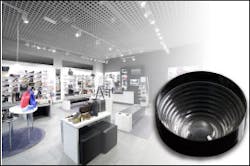LEDiL unveils new LED optics portfolio, adds Florence, Carmen, and Strada products
SSL product developers can now buy optics designed for stringent IP requirements from LEDiL, while the company also has a new hybrid lens/reflector optic, and more options for outdoor area lighting.
LEDiL has announced additions to its Florence, Carmen, Zorya, and Strada LED optics families. In the Florence family, solid-state lighting (SSL) product developers can now specify versions with elevated ingress protection (IP) support for challenging dusty or moist environments. A new hybrid reflector/lens optic in the Carmen family targets demanding high-end retail applications. New Strada family products deliver additional beam distributions for street and area lighting and one model is intended for geographies that have frequent rain. And a new Zorya product can deliver 340° beam distribution for omnidirectional replacement lamps.
Interested in articles & announcements on LED optics & other SSL design topics?
Strada expansion
Perhaps the most significant expansion of SSL optics came in the Strada family. The 2×2- and 2×6-array Strada-2X2-FW and Strada-IP-2X6-FW optics deliver what the company calls a forward-wide light distribution and supports Type III street light beams. For more information on outdoor beam patterns, see a basic primer on the topic we published several years back.
The 2×2 array is intended for applications such as residential suburbs whereas the 2×6 array can support busier roadways and other area lighting including high-mast applications. In both cases, the optics limit backlight to just the typical sidewalk area. And the optics were developed to maximize pole spacing through the wide beam distribution. LEDiL further added IP67 capabilities in the larger optic that can increase the reliability of luminaires in a harsh environment. We will discuss IP67 capabilities in more detail momentarily.
Meanwhile, the third new Strada-2X2-MEW is designed specifically for lighting streets in a wet environment. The optic meets Nordic wet street lighting requirements and delivers a Type II beam. Photometric properties that favor use in a wet environment include very low glare and uniformity across two traffic lanes with minimal reflection. LEDiL further added the Strada-SQ-T2-B single-LED optic with a Type II beam and minimal backlight.
Carmen and Zorya
Moving to retail applications where lighting designers and specifiers demand tight beam control and top optical performance, new Carmen products combine refractive light control that’s common with total internal reflection (TIR) lenses and reflective control typical of directional lamps and luminaires. The optics family supports chip-on-board LEDs with a light-emitting surface as large as 11 mm.
The new Zorya-MINI is also all about beam control, but for an entirely different application. The product can support globe, candle, or A-lamp form factors. And developers can use LEDs as large as 7×7 mm in footprint with the hemispheric-shaped design. Indeed, LEDiL said the intent of the product is to give retrofit lamp developers more freedom in LED selection.
Florence for harsh environments
The final family we will discuss is the Florence and yet another example of an optic product that offers IP67 protection. A feature article that we published on the need for venting luminaires includes a comprehensive discussion of IP levels. The first number in the sequence covers solid or dust ingress and 6 is the top rating indicating a dust-proof product. The second number conveys water ingress and a 7 is the penultimate rating indicating that immersion in water is tolerated for 30 minutes.
The Florence-3R-IP-PC is a 3×11-array optic that includes a silicone gasket to achieve IP67 protection. LEDiL identifies targets such as industrial applications for the optic, although specifically described its usage in a luminaire intended for deployment in car washes. Models deliver 60°, 90°, or oval beams and LEDiL said they hide pixilation from the LEDs. The mechanical design is compatible with Zhaga Book 7 rectangular light engines and works optimally with mid-power LEDs. Zhaga announced the Book 7 specification back in 2013. For more background on Zhaga Books, see a feature on the organization’s work.

Maury Wright | Editor in Chief
Maury Wright is an electronics engineer turned technology journalist, who has focused specifically on the LED & Lighting industry for the past decade. Wright first wrote for LEDs Magazine as a contractor in 2010, and took over as Editor-in-Chief in 2012. He has broad experience in technology areas ranging from microprocessors to digital media to wireless networks that he gained over 30 years in the trade press. Wright has experience running global editorial operations, such as during his tenure as worldwide editorial director of EDN Magazine, and has been instrumental in launching publication websites going back to the earliest days of the Internet. Wright has won numerous industry awards, including multiple ASBPE national awards for B2B journalism excellence, and has received finalist recognition for LEDs Magazine in the FOLIO Eddie Awards. He received a BS in electrical engineering from Auburn University.






